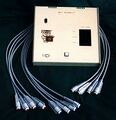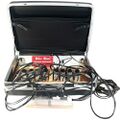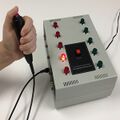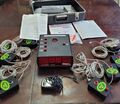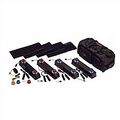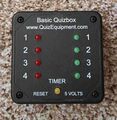Difference between revisions of "Buzzer"
Matt Weiner (talk | contribs) |
Matt Weiner (talk | contribs) |
||
| Line 97: | Line 97: | ||
File:Quizmaster.png|Manufacturer: Erickson<br>Model: Quizmaster|alt=alt language | File:Quizmaster.png|Manufacturer: Erickson<br>Model: Quizmaster|alt=alt language | ||
File:Quizamatic.png|Manufacturer: University Research Company<br>Model: Quizamatic. The physical bell which produces the sound upon "buzzing" is visible.|alt=alt language | File:Quizamatic.png|Manufacturer: University Research Company<br>Model: Quizamatic. The physical bell which produces the sound upon "buzzing" is visible.|alt=alt language | ||
| + | File:Esl-slamsystem.png|Manufacturer: ESL<br>Model: Slam System.|alt=alt language | ||
| + | File:Quizsystems-QS2000A.jpg|Manufacturer: Quiz Systems<br>Model: QS2000A|alt=alt language | ||
</gallery> | </gallery> | ||
Revision as of 08:43, 10 December 2022
Tossup-Bonus Format
(Tossups · Bonuses)
Studying · Writing · Editing
NAQT · ACF · Housewrites
The circuit · Outreach
Resources
hsquizbowl.org
(database · archive · forums)
Discussion forums
College directory
Buzzer system, buzzer, and lockout system are the common names for the device used to indicate which player has signaled their desire to answer a question first. Such systems are necessary for all standard quizbowl games because they make it clear which player was the first to attempt to answer a question.
While using a buzzer system, players buzz to answer a question. Other players are prevented from buzzing ("locked out") after one player has buzzed until the system is reset.
A buzzer system consists of a control unit that sits near the moderator, which connects to individual buttons or paddles held by each player. When a player buzzes in, the system produces a sound and activates a light indicating which player buzzed. Many more expensive systems have individual lights next to each player, while most lower-priced systems have smaller lights or light only on the control unit.
Almost all tournaments require some number of teams to bring buzzers in order to have enough to run the tournament properly; for this reason, Tournament directors usually offer a discount to teams that bring a buzzer. When too few buzzers are present, teams must play slapbowl, where buzzing is indicated by slapping the desk or saying something like "buzz." This is no longer common in the vast majority of modern quizbowl tournaments.
Online tournaments typically use an online buzzer system like Buzzin.live, which functions in much the same way as an in-person buzzer. It is possible to use USB buzzers attached to players' computers, but this is impractical and rarely used.
History of Quizbowl Buzzers
The earliest quizbowl-style competitions appeared to use either a system of hand-raising (sometimes with other officials activating a buzzer after seeing a hand raised) or shouting the answer before the other team. The College Bowl TV show implemented a buzzer system as part of its studio set, but portable buzzers took longer to emerge. The Berry College team in 1971 created a home-made portable buzzer system while a patent for a portable buzzer system was filed in 1972. Previous "lockout" buzzer systems had been used by Bible Bowl as early as the 1960s, but they were apparently not very portable.
Some older buzzer systems used a mechanical bell that was rung when players buzzed-in instead of making a "buzz" sound. Almost all modern buzzer systems now have some kind of light that indicates who buzzed in first.
Choosing a buzzer system
There are many things to take into consideration when deciding which buzzer system to purchase including price, durability, portability, and other factors. Below is a brief overview of Em Gunter's guide to choosing a buzzer system on the hsquizbowl.org forums. This covers 4 of the most commonly seen systems that can still be purchased as of March 2020 (thus leaving out The Judge, which appears to be unavailable for purchase anymore, but which due to its near-indestructibility remains present on many circuits).
Anderson Buzzers: [$265-$290]
Anderson buzzers come in two versions: daisy-chained boxes and individual hand-held indicators. purchasing the daisy-chained version is suggested due to their ease of use and high durability. When disassembled these buzzers only have 4 parts making it nearly impossible to accidentally leave part of the system lying around. The control unit is a simple box and each strip of buzzers connects on either side of the unit. These buzzers are extremely durable and are only known to fail in cases of extreme negligence. Andersons are the cheapest and most reliable buzzers that can be purchased and are often recommended over any other system. In general, it is a much better idea to purchase two sets of Andersons rather than a single set of QuikPros or Zeecrafts due to the far superior build of the Andersons. The one downside, however, to Andersons is that the AC adapter for the system is extremely short so purchasing an extension cord is highly suggested.
BuzzerSystems.com Buzzers: [~$299]
The buzzers from BuzzerSystems.com feature a control unit with individual activators contained within boxes that connect to the control unit by audio cables. The control unit features a reset button and 16 ports to allow the support of up to 16 players which is higher than any other commonly found system. Set up of this system is slightly more complicated than the Andersons because you have to plug a cable into each individual activator and a port on the control unit. Players who enjoy holding their activator but are seeking a higher quality or cheaper set will most likely prefer this set over Andersons. The main downside to this system is the quality of the cables that come with the set when you purchase it. When purchasing this system it is recommended that you additionally invest in a set of replacement cables that can be found at Amazon or a local electronics retailer.
QuikPro Buzzers: [$289-$489]
QuikPro buzzers come in two general types. You either have hand-held activators directly connected to the control unit from a single connection or individual lights with hand-held activators attached. The version with hand-held activators but not lights are generally far more reliable than the version with individual lights. QuikPro buzzers use cables similar to those used for home telephones and the connectors are often prone to snapping. The reset button on QuikPro buzzers can often fail due to poor wiring and may require the splicing of new wire in for continued functionality. The set up of this system is fairly simple but there are many cords that can easily get tangled or damaged which can increase set up and tear down time significantly compared to other systems.
Zeecraft Buzzers: [$465-$730]
These are by far the most expensive buzzers you can buy and while they look extremely nice they don't hold up very well. Many people have experience with these sets as they commonly show up at various national championship tournaments. Zeecraft systems have 8 individual lights with individual hand-held activators. The individual lights themselves are extremely fragile and will crack or pop off if they fall on the ground or jostle inside the case. The buzzers connect to the control unit using telephone cables and the clips on these tend to snap off quite easily. The craftmanship of Zeecraft buzzers is inferior to that of other systems. The soldering is often messy and these systems fail significantly sooner than other systems available for purchase. Additionally, Zeecrafts are incredibly time-consuming to set up and take even longer to put away due to the barely-big-enough case designed for the system. Taking into account the very high cost and lack of durability it is suggested that you stay away from Zeecraft buzzers for individual team use.
Purchasing a buzzer system
New quiz bowl programs commonly ask how and where to buy a buzzer system. Overtime all buzzers break down, so it is often better to purchase more durable systems such as Andersons, which are the cheapest and provide good warranties, than to a more expensive system because it looks better or you have heard rumors that it is less likely to fail. Local civic organizations are a good place to reach out to if your school division denies funding for a buzzer system.
There are other concerns about buying a buzzer system for quiz bowl:
- Quiz bowl does not use "self-resetting" systems; you should buy a buzzer with a moderator reset button.
- Wireless buzzer systems are inappropriate for tournament play due to the potential for lag.
- Phone- and tablet-based buzzer systems are inappropriate for tournament play and serious practice due to the potential for distraction or cheating by using such devices' other functions.
- Battery-operated buzzer systems will require you to always keep spare batteries in the case in the event of a mid-tournament battery failure. For tournament use, systems plugging into building power are preferred (it helps to keep an extension cord in the case because some rooms have inconveniently-located power outlets).
- Individual player lights on or next to each player's buzzer make it easier for everyone to recognize who has buzzed in first.
Matt's Buzzers
Matt's Buzzers is a charity set up by Sheryl and Mike Cvijanovich, the parents of Matt Cvijanovich. It awards grants to teams seeking to buy buzzer systems. These grants are given in Matt's honor.
Terminology
"Buzzer system" (used in most mainstream quizbowl) and "lockout system" (used in College Bowl) are the most common terms. Game shows such as Jeopardy! that use similar systems refer to them as a "signaling device." The terms "indicator system," "lockout/indicator," and "quiz box" are seen occasionally.
Official systems
While almost all tournaments allow any buzzer that meets their technical requirements and rarely have the luxury of turning away any working buzzers supplied by teams, some models are more common in certain environments:
- NHBB endorses the Anderson Officiator to teams and uses that model for their company-owned reserve of buzzers.
- The several dozen buzzers owned by NAQT are the kind made by NED.
- VHSL Scholastic Bowl uses a stock of Quik Pro Deluxe buzzers at its state tournament and endorses Quik Pro for purchase by participating teams.
- Off-TV College Bowl used Zeecraft Challenger I buzzers at its official events. The purchase of this model by colleges running intramural tournaments and the subsequent end of the College Bowl campus program may explain this buzzer's frequent appearance on secondhand resale websites.
The Quik Pro Deluxe "siren" style buzzers provide some advantage in games played before large audiences, as they have by far the largest lights, and the only large lights that are omnidirectional, of any available system. In extreme cases (e.g. national finals games played on stages in hotel conference rooms in front of hundreds of people) there is no buzzer that lights up brightly enough to overcome the combined effects of the stage lighting and the size of the room, and the audience has to rely on listening to who is answering the question to determine who buzzed.
Gallery of buzzer systems
Manufacturer:Paléogénies
Model: Unknown model name used for Génies en herbe and related competitions in QuebecManufacturer:
Model: Bible Bowl system that was produced by third-party builders & also made freely available as a schematicManufacturer: Ion Electricals
Model: System used in Indian quizzing




